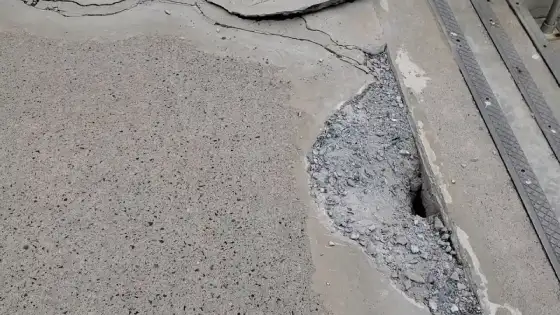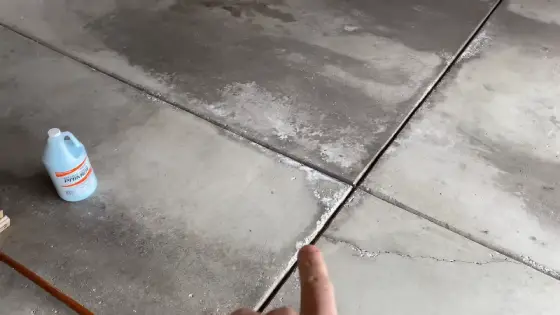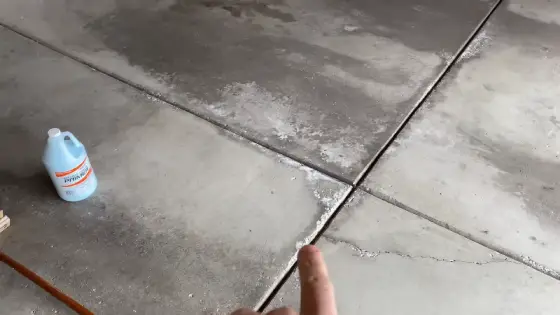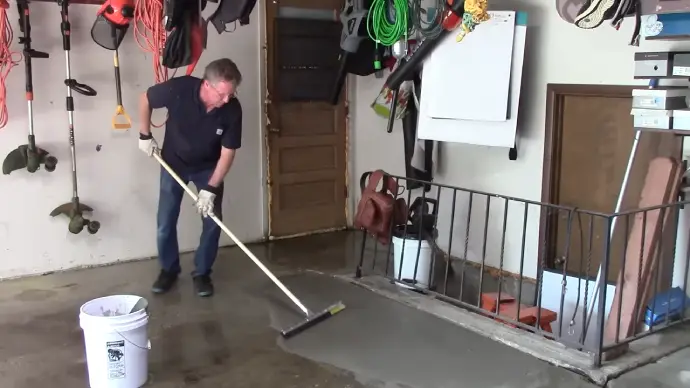Concrete sectional garages are popular for those seeking extra storage or workspace on their property. However, a common issue homeowners encounter with these structures is leaks, which can cause damage to the interior and any stored items.
To address this problem, the first step is surface preparation, which involves cleaning and drying the surface to get a good seal. Next, caulk is applied to base joints to prevent water from leaking through. Finish it off by applying sealant and smoothing out bumps and ridges.
Discover the tactics for securing your concrete sectional garage from pesky leaks. Learn how they start and the secrets to preventing them from ever ruining your space again.
How to Seal a Concrete Sectional Garage From Leaks: Easy Steps

To prevent leakage in a concrete sectional garage, crucial steps must be taken for an effective seal. Among them are:
- Step 1. Surface Preparation
- Step 2. Caulk the Base Joints
- Step 3. Choosing a Concrete Sealant
- Step 4. Applying the Concrete Sealant
- Step 5. Finishing Touches
Let’s discuss these steps in detail:
Step ONE: Surface Preparation
Before moving on to the next steps of the process, it is crucial to prepare the surface by cleaning it thoroughly. Use a wire brush or sweep to eliminate loose particles from the walls and garage floor.
Additionally, inspect the surface for any visible cracks or gaps. These should be fixed using a concrete patching compound, following the manufacturer’s instructions for the specific product being used. Ensure the surface is dry before moving forward.
Step TWO: Caulk the Base Joints
Sealing the base joints where the floor meets the walls is important to prevent moisture from leaking into the structure, which can cause costly damage. One effective way to seal these joints is by applying a bead of silicone caulk along the base joints.
This material is flexible and waterproof, which makes it ideal for filling in gaps and cracks in the concrete surface.
To get the best results, it is important to smooth the caulk with a caulk smoothing tool or a wet finger to ensure a proper seal. This will help eliminate air pockets and ensure the caulk adheres firmly to the surface.
Step THREE: Choosing a Concrete Sealant
Selecting an appropriate sealant type is crucial in ensuring the longevity and protection of the garage floor. Available options include spray-on sealant, paint-on sealant, and epoxy garage floor paint. Each type has unique properties and advantages, which must be considered when choosing.
Spray-on sealants offer a quick and easy application process, making them ideal for beginners. On the other hand, paint-on sealants provide more durable and long-lasting protection, making them ideal for high-traffic garages.
Epoxy garage floor paints offer superior adhesion and chemical resistance, making them ideal for garages used for heavy-duty activities.
Step FOUR: Applying the Concrete Sealant
To ensure the durability of the garage, it’s crucial to protect vulnerable areas from water infiltration by applying an appropriate sealant. This step provides homeowners with a sense of security and peace of mind.
Apply a continuous and even bead of concrete sealant to the garage floor’s edges, both inside and outside, to cover all vulnerable areas. This ensures a thorough and effective seal against water seepage.
Next, create a waterproof angled fillet of mortar between the garage floor slab and the wall joint. For this, follow the manufacturer’s instructions to mix the mortar and use an angled trowel to apply it in a curved fashion.
Finally, seal the gap between the plaster and concrete base, leaving a distance between the materials to account for expansion and contraction. Use a concrete sealant to apply another bead, which increases waterproofing and prevents water infiltration.
Step FIVE: Finishing Touches
To make sure the whole floor has been sealed properly, it’s important to do a thorough inspection after the sealant has dried. Take a walk around the garage and check carefully for any spots that were missed or not covered completely. If any areas need additional sealant, touch them up to ensure complete coverage.
What Causes the Sectional Garage to Leak When It Rains?

When it rains, sectional garages may experience leaks due to various reasons. Understanding these potential sources of leaks can help homeowners better prevent and address water damage in their sectional garages.
One: Clogged Drains
Clogged gutters and drains are a common issue that can result in water damage to nearby structures. Debris such as leaves and twigs can accumulate in these areas, obstructing rainwater flow and causing water overflow onto driveways, garages, and homes. Such overflow can cause structural damage and hazards.
To avoid such hazards, it is essential to perform regular maintenance inspections on gutters and drains, checking them a few times a year and removing any blockages found. Installing gutter filters that permit water flow but prevent debris accumulation can also prevent future blockages and ensure proper drainage.
Two: Leaking From Pipes In Dry Wall
Leakage in garages can be caused by damaged pipes that run through the drywall. Burst or cracked pipes can result in water seeping through walls and causing expensive damage to the garage and its contents.
Remove the damaged drywall and expose the broken pipes to address this issue. Repair or replace the broken pipes to prevent further leakage. Then, apply tanking slurry to waterproof the walls completely. Tanking slurry is a waterproof coating that acts as a barrier against moisture.
Three: Leaking Through Cladding
Older garage cladding can be damaged, causing water to infiltrate and potentially damage the interior. Cladding serves as a first line of defense against the elements and needs proper maintenance.
Water can penetrate the cracks when damages occur, resulting in interior damage. To prevent long-term leaks, a complete replacement of the cladding is recommended. However, temporary spot repairs can be effective until a full replacement is scheduled.
Considering expansion gaps when replacing the cladding is essential to allow for expansion and contraction with temperature changes. The cladding can buckle or warp without expansion gaps, resulting in potential leaks and further damage.
Four: Expansion Gaps
When building a garage, it is important to carefully consider and implement expansion gaps between concrete slabs to prevent damage and water infiltration. The gaps allow for necessary expansion and contraction as temperatures change. Two smaller slabs with an expansion gap are typically used.
However, these gaps can create potential entry points for water, leading to leaks and damage. To prevent infiltration, a concrete expansion gap filler that is suitable for the type of garage and expected traffic should be used.
Does water come up through concrete garage floors?

Due to seasonal water table rises, it is not uncommon for water to seep through concrete garage floors. This issue is often a result of shallow groundwater being unable to properly drain away from the area, leading to moisture buildup.
While controlling deep soil moisture around the house may prove difficult, addressing flaws in the concrete garage floor can effectively mitigate this problem. You can prevent water infiltration and protect the garage’s foundation by using specialized methods like vapor barriers or waterproof sealants.
It is recommended to seek the services of a professional contractor with experience in addressing garage floor moisture issues for optimal results.
What happens to concrete when water sits on it?
Water resting on concrete for an extended period can create multiple problems. For one, the water infiltrates the surface’s pores, providing an ideal environment for mildew and mold growth. This leads to foul odors and potential health risks.
Additionally, the standing water can cause the concrete to crack and shift, becoming hazardous to walk or drive on. This issue differs from water rising from underneath the surface due to poor drainage or a high water table.
When this occurs, hydrostatic pressure can increase, allowing water to permeate small cracks and gaps, ultimately compromising the structural integrity of the surface. Therefore, it’s crucial to maintain proper drainage and prevent water from resting on concrete surfaces to avoid damage and safety risks.
Is it possible for water to come up from under the garage concrete?
It is certainly possible for water to seep up from under a garage’s concrete floor. In fact, water can come up through any concrete structure that is not properly sealed, which can lead to serious water damage and compromise the safety of your property.
Numerous factors can cause water accumulation around your garage foundation, such as intense rainfall, melting snow, and inadequate drainage. Insufficiently sealed concrete may enable water to infiltrate the walls, flooring, and even the ceiling, particularly when groundwater levels are elevated.
This not only creates an unpleasant and unsanitary environment but can also lead to mold development and the weakening of the structural integrity of the garage. Therefore, it is essential to ensure proper drainage systems and sealing techniques are in place to prevent water damage.
Protect Your Concrete Garage with Proper Sealing
The upkeep of your concrete sectional garage is of utmost importance to ensure durability and prevent costly damage to its structure and contents. Proper sealing is essential to safeguard against potential leaks, which can cause untold harm.
Identifying the source of the leak is crucial before attempting repairs and may require professional intervention. Regular cleaning and inspections can prevent leaks from occurring. Inadequate drainage systems cracked walls, and floors are all potential problem areas that can be addressed with the appropriate maintenance.
With due diligence and attention, you can keep your garage in top condition and avoid substantial repair and replacement costs.
